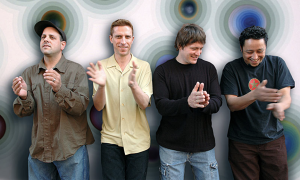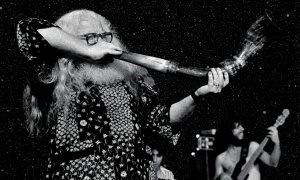Home » Jazz Articles » From the Inside Out » Pictures Without Borders
Pictures Without Borders
White's gut-level vocal cuts through the music but remains part of the overall picture, like the howl of a distant, unseen freight train passing through the scenery of the night.
Sons of Armageddon
The Softest Touch
Magic Pony Records
Colorful, complicated and compelling, this topped my list of the best releases from 2004.
SOA is comprised of five members but employs musical weaponry far from your standard jazz quintet: Lewis "Glewlio" Keller on turntables, laptop, theremin, synthesizers, melodica, and guitar; Mark Prather on percussion, samples, and machines; Cameron "Slammy" Thompson on samples and drums; Tim Hochman on bass and post-production; with Kirk Knuffke on trumpet the main solo voice, plus alto saxman Dav Poli Hoof guesting on "Shambles Factory." A different shape of band for the different shape of jazz things to come.
Knuffke's trumpet solos and the trippy, thick psychedelic stew from which they bubble have led some press to hype The Softest Touch as a mythical post-millennial collaboration between the late Miles Davis and bassist / producer Bill Laswell. "A Thousand Kisses Deep" sure sounds like Laswell dub, as does "E. S. Smothered," which stitches in colorful electronic patches where Laswell usually employs Indian, Asian or African percussion instead.
The comparison to Davis flatters Knuffke but not by too much. Mark Isham is probably closer. He sure knows how to make a cinematic and dramatic entrance - floating his first suspended notes over the squall and clamor of "Hoels," then precision dive-bombing with Hochman's rumbling bass line to swarm the beat in a machine-gun flurry of notes in its closing. As for the band, SOA describes their sound as "post-apocalyptic electro-jazz for the pre-apocalyptic listener." It's as close as anything else, so why the hell not?
The centerpiece "Dubya" begins in atmosphere and percussion. Then bass pads out from under its cover with loping powerful strides as trumpet rides atop, surveying the scene like the king of the jungle with a hungry omniscient eye and cutting back in after the break to ferociously flay the beat. Occasional bits of New Orleans snare drumming gives Knuffke a more fluid ride in "The Diddler," at least until the bass solo mutates into jarring, h-u-g-e electronic four / four beats pockmarked with sound snippets to close.
MAN, is this stuff hard to describe!
If I managed or owned a retail shop, I'd keep three copies on hand so that folks could find The Softest Touch under Modern Rock (from its attitude), Electronic Music (from its instrumentation), or Jazz (from its trumpet solos). It seems to belong and to not belong in each group. That's sort of why this is my pick for "Best of 2004" - not only because of its music but because of what its music and music like it foreshadows for music in the future. It seems almost impossible to say that this is or is not a Jazz record.
 Choing Drolma and Steve Tibbetts
Choing Drolma and Steve Tibbetts
Selwa
Six Degrees
Like Cho, the first collaboration between Drolma and Tibbetts (in 1997), Selwa honors the sacred music of north and south Asia and delivers a profound example of the modern music world as a global village. It showcases recordings of Buddhist nun Ch?g Drolma made by percussionist Marc Anderson and guitarist Steve Tibbetts, both from Minnesota, at a Tibetan Buddhist enclave in the Himalayan country of Nepal. Anderson and Tibbetts returned to Minnesota to huddle with Lee Townsend, producer for such star guitarists as Bill Frisell, Pat Metheny, John Scofield, Charlie Hunter, John Abercrombie, and the guitar ensemble T.J. Kirk. The three then wove enchanted percussion and guitar instrumentation around Drolma's chanted prayers and supplications.
Townsend's help proves no small touch. His multi-tracking the vocals in "Song of Realization" makes them seem to intertwine, to strive onward and upward like mythical vines growing toward the sun. Resonant echo on her voice makes "Yumchen Tukar" feel even more reverent.
Selwa is ethereal, evocative, and breathtakingly beautiful. Tibbetts and Anderson seem to intuitively understand how to accompany Drolma's voice, building in "Paiden Rangjung," for example, a mountain of percussion and guitar from which Drolma's vocal steps right off the crest into pure nothing.
The spacious instrumental introduction to "Mandala Offering," where guitar waterfalls splash against thumping percussion and shimmering cymbals - appearing, disappearing, then reappearing - is beautiful and inscrutable, pastoral Pat Metheny taken to the abstract. Tibbetts and Anderson also somehow intuit the ebbs and flows of the centerpiece "Song of Realization." Drolma completely dissolves herself in this hymn to the point where you cannot distinguish between singer and song.
"Vakritunda" is the most rhythmically active piece, with Drolma's phrasing sometimes suggesting a Middle Eastern dervish and Tibbetts moaning the blues - perhaps in different tones, but with the familiar spirit of blue heartache. Drolma's voice soars and floats through "Chenrezi" and "Chendren" as the very picture of a white dove in a pure blue sky and there's no more fitting way to end this set than the unaccompanied vocal "Je Loma" - alone with that voice in the hallowed chapel of her soul.
Listening to Selwa always makes me feel so quiet and still. And very very small.
Chris Bottomley
Knotty Bits
Partly Bent
He's from Toronto, but with titles such as "African Head Dub," "Brazilian Thunder Throb," "Belize City Bakin'," and the geographically ambiguous "World of Dreams," this third release from this producer, composer, multi-instrumentalist and singer reflects an international musical vision.
"Belize City Bakin'" strolls you down a colorful reggae lane with easy to remember lyrics set to a catchy tune; you're serenaded in the bridge by trumpet and flute, then warmly toasted all over with a crisp horn chart. The set-ending "Belize City Bakin' in Dub" twists and fires up more heady, psychedelic stuff.
The cool instrumental "African Head Dub" opens with the thump of hand-played percussion and an insistent buzzing bass line that drives its rhythm AND melody home. "Brazilian Thunder Throb," its complement, adds horns and scat vocalese that joyously skirts the melody.
Bottomley plays almost everything - bass, acoustic guitar, percussion, djembe, jews' harp - and sings. When he teams with Jono Grant, who contributes guitar, piano and other keyboards and percussion, the two leave almost no instrument on the shelf. The pair co-produced "Trouble Makin' Freak" and "Hanging to the Riverbank," tightly arranged large ensemble funk flowing full of sophistication and style, two of Bottomley's best.
Bottomley stretches further out on "Sample the Potion" and "Spider Woman." The lead horn chart in "Potion" is one of his best melodies, and the snare drum accents one beat early to move its rhythm continuously forward. "Spider Woman" also swaggers with a cool blue-tinged horn chart, saxophone cooing through the breaks, creepin' bass line, and wah-wah synthesizer funk, while the drum maintains its impeccable ride across the cymbal - the purposeful undulations of a murderously cool and attractive femme fatale.
Bottomley and Grant are joined by drummers Dean Stone, Davide Lorenzo, and Mike Goodridge, brass and wind players Rick Underhill, Jim Bish, and Bryden Baird, Andru Branch on Hammond B-3 organ, Ken Myhr on guitar, moog and mellotron, and guitarist Moose (Tomas). Though their musicianship is unquestionable, the stars of this set are Bottomley's jazzy pop songs.
Ray's Music Exchange
Blue in the Face
Ray-Mayd
It's generally considered bad writing to describe one thing in terms of something else that the reader may also need described. This may be considered bad writing, then, but I've gnawed for weeks on this Cincinnati quartet's second studio release, and fifth overall, and this is my best attempt at describing its sound:
Imagine yourself in a room with two CD players. One plays the horn-driven bop of a late-model Jazz Messengers and the other features the guitar-stoked progressive rock of King Crimson. Except that the CD players keep cutting in and out and over each other, so that sometimes you only hear progressive guitar rock, other times just funky hard bop, and sometimes horns bopping hard and funky on top of progressive rock guitar.
Got that? That's Blue in the Face.
Nick Blasky on bass and vocals; Brad Myers on guitar; Eli Hludzik on drums; and Michael "Mad Dog" Mavridoglou, who also splits time in Jazz Mandolin Project, on keyboards and trumpet; form a true jazz-rock quartet that, with special thanks to guitarist Myers and trumpeter "Mad Dog," jazz AND rock fans would be wise to explore.
"Gapers" and "Bowie Knife" (where Steve Kortyka guests on alto and tenor sax) end up more than the sum of their jazz-rock parts as Hludzik dips his sticks into the pool of liquid Crescent City funk (especially on snare), Myers shakes out feelin'-loose rock grooves, and Mavridoglou's trumpet busts out bebop and blues. Trumpet leads the ensemble through the melody sections of the ten-minute "Free Ride and a Hotplate" like a Jazz Messengers tune (think Terence Blanchard), alternating with guitar interludes until one erupts into a free-for-all that sets the table for more Mavridoglou.
Myers' flash guitar illuminates the electric spectrum of prog-rock explorers Bill Nelson and Robert Fripp, his angular, oddly rhythmic lines showcased in the scalding hot "Jimmy Jenga" (fusion wrapped tighter than shrink-wrapped crystal) and as the only soloist in "Red Rocket."
"Watch the Lights" provides a great description of this jazz-rock instrumental as, on top of churning bass and hard metal drums, measured half-notes switch on colorful, fat light bulbs in single file. "Mad Dog" drops in a Spanish trumpet interlude, a Latin tinge reinforced in the subsequent "Boris the Bedsnake," serpentine jazz-rock fusion with seething Latin passages led by trumpet. Myers burns this one up, too, with a solo that skirts Latin, jazz, AND rock styles.
(The name of Ray Charles' music shop in the original Blues Brothers movie was: Ray's Music Exchange.)
Greyboy
Shades of Grey
Ubiquity
The CD cover of this new set reads: "This recording is a live, raw, unfiltered DJ session by DJ Greyboy and contains many rarities and exclusive mixes." Nearly one hour of constantly kaleidoscopic dancefloor motion and commotion - what a great introduction to the mad skillz of San Diego producer, mixmaster, DJ and turntablist Andreas Stevens!
It's almost impossible to tell what records, or even how many, Greyboy loops, scratches or spins in and out at any point. It is clear, though, that Shades of Grey features several previous Greyboy offerings: His remix of "Genevieve" melts into his remix of "Got to Be a Love," and he later throws down the original version of "Gotta Stand for Something," all of which appeared in one form or another on his previous studio effort Soul Mosaic: A Case Study in Beats, Soul and Funk. Cool vibes like crystal water droplets send refracted basslines and backbeats shimmering out into the night in "Bath Music" (from Mastered the Art , the album before that), which drips out slowly to end the set. Surprisingly, "Genevieve," where the music and vocals don't quite seem to match up in key, is the only wet blanket tossed on this crackling fire.
The fat hits the fire right away with his opening scratch-up dust-up of "Finger Licking Good" (Richard "Dimples" Fields). Scratches and loops drop the beat completely out, then pull it back in, morphing "Finger Licking" into "Sad Chicken" (Leroy & The Drivers), and later propelling the barrio-style "Laid Back Funk" (Darkness of Evil - think classic War with a fat dollop o' P-Funk in its stanky bottom) into the funk bucket like a rubber band slingshot.
Jazzheads should check The Messengers' "Hancok's Hideaway," which thumps through bumping beats like a big-nosed hound dawg lumbering always one step behind a wabbit in the shade of Blue Note horn charts, plus the tribute to Jobim's classic by Roy Porter cleverly titled "Wavering," a fusion-y exploration of one of Antonio's more popular melodies (perhaps the most recognizable song here, and easily the longest) on keyboard, saxophone, and electric guitar.
Even if you don't care much about how Shades of Grey splices together different sounds and styles, you can still throw this down and let it roll through your next party. Just act appropriately humble when someone compliments your exquisite collection of underground club and soul classics.
 Various Artists
Various Artists
What is Hip? Remix Project Volume 1
Warner Bros.
This is probably the release I had the most fun with - laughing alongside friends at parties, singing at the top of my lungs alone in the car with, fun - in 2004. Folks in or around their forties (such as yours truly, H.S. class of 1978) will find that this collection of classics Warner Bros. pop catalog, remaked / remodeled by the most modern of contemporary remixers and beatmasters, hits their sweet spots for new music AND nostalgia.
Soft, trippy romanticism gently shimmers from the Tsuper Tsunami mix of "Summer Breeze" (Seals & Crofts) by executive producer Philip Steir and Ramin Sakurai, echoing the Isley Brothers' classic cover of this same song. It positively POURS from Boozoo Bajou's (Peter Heider and Florian Sevberth) Georgia Dub of "Rainy Night in Georgia" (Tony Joe White - Brook Benton had the more familiar popular hit but it's White's composition), a tempered groove romantic and soft and dark and lush as a damp Georgia evening. White's gut-level vocal cuts through the music but remains part of the overall picture, like the howl of a distant, unseen freight train passing through the scenery of the night. Thick and steamy, this is so good I don't even remember the original and it's STILL my favorite piece here.
Assembled by Nightmares on Wax, "This Masquerade" (George Benson) presents another deliciously atmospheric production, full of darkened, stark piano chord drama and an exquisite break when the tape speed slows to a complete stop then cuts right back in, sounding like it must have dropped a beat somewhere though it does not.
The party starts from the opening track, "Listen to the Music" (Doobie Brothers) polished to a sparkle by DJ Malibu. The introduction is made to sound more dance-able, like something from Michael Jackson's Bad catalog (as opposed to Jackson's "lousy" catalog, a different story). Bass and drums into and out of the verse / chorus breaks are sharpened to toothsome grins, and Malibu's mid-song vocal / drum beatdown is transcendent, absolutely begs you to sing along, and could not have been written into the original because such breaks were not part of music's lexicon circa 1972.
For giggles, jump into the Euro-electro-club rhythm bed that Cuica folds underneath "Midnight at the Oasis" (Maria Muldaur) or bounce off the walls with the clattering spastic reggae "Whip It" (Devo) by executive producer Phillip Steir with Ramin Sakuri, so rhythmically perfect you wonder why you never heard this song done in this style before.
Miles did it with "My Funny Valentine." Benson did it with "This Masquerade," written and recorded first by Leon Russell. Updates of pop standards that create new classics while maintaining their ties to the familiar also reopen, in my mind, the question, "Is this Jazz?"
< Previous
Michael Marcus Takes the Iron Horse t...
Next >
Jazz Tribute for MLK
Comments
Tags
For the Love of Jazz
 All About Jazz has been a pillar of jazz since 1995, championing it as an art form and, more importantly, supporting the musicians who create it. Our enduring commitment has made "AAJ" one of the most culturally important websites of its kind, read by hundreds of thousands of fans, musicians and industry figures every month.
All About Jazz has been a pillar of jazz since 1995, championing it as an art form and, more importantly, supporting the musicians who create it. Our enduring commitment has made "AAJ" one of the most culturally important websites of its kind, read by hundreds of thousands of fans, musicians and industry figures every month.






















